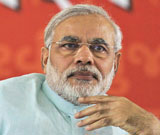
New Delhi/Ahmedabad, May 7: Gujarat Chief Minister Narendra Modi's role in the 2002 riots in the state should be probed, Raju Ramachandran, the amicus curiae appointed by the Supreme Court in the case, has said in his final report.
According to the report dated July 25, 2011 which was released Monday, there was a need for examining Modi's role in the wake of the Godhra train burning to find out whether a message was mesage was conveyed that the state machinery would not step in to prevent the communal riots that followed.
Ramachandran says the chairman of the Supreme Court-appointed Special Investigation Team (SIT) had found that a meeting had indeed taken place at Modi's residence at 11 p.m. on February 27, 2002 that was attended by senior bureaucrats and police officers.
The report terms as incorrect the claim of Indian Police Service officer Sanjiv Bhatt, the then Deputy Commissioner of Police (Intelligence), that he was present at the meeting.
Meanwhile, a court in Ahmedabad on Monday handed over a copy of the SIT report on the Gulbarg Society massacre to Zakia Jafri, a month after the SIT found no prosecutable evidence against Modi. The report is 25,000-pages long.
The court has asked Jafri to file an application on May 10 if she feels there are discrepancies in the report or that documents are incomplete. Jafri has asked for two months' time before arguments can begin in the case.
The SIT report had sought a closure in the probe as it found no evidence against Modi.
Zakia Jafri is the widow of former Congress MP Ehsan Jafri who was among 69 persons killed in the Gulbarg society carnage. She had named Modi and 57 others for alleged criminal conspiracy in the 2002 riots. Zakia has also been given a copy of the amicus curiae's report.




Comments
Add new comment